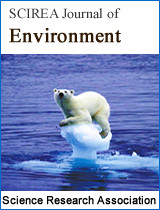Environmental Impact of Quarry Activities on Resident of Akure Region, Nigeria
DOI: 312 Downloads 5071 Views
Author(s)
Abstract
The quarrying industry is of vital importance to all aspects of modern day life and development. However, searching, locating and extracting materials used for construction activities pose some problems to the environment which normally result in the damaging of the immediate environment and atmosphere. The aim of study is to assess the environmental impact of quarry activities in Akure region and identify the hazards associated it. Structured questionnaire and field observations was administered to elucidate data on socio-economic characteristics of the residents; vibration effects; building damages; health effects and impact of quarry activities on the environment. There were 2900 buildings in the study area which constitute the research population. The sample size of 10% was adopted, hence 290 copies of questionnaires was administered in the study area. The study also employed ArcGIS software to determine the extent of land area that is affected by pollution as a result of the quarry activities in the study area. The research also made use of IKONOS imagery for Geographical Information Systems GIS) to buffer and extract buildings that are within 3km radius. Results obtained show that most buildings that fall within buffer zone to quarry site have high risk such as air pollution, noise pollution and health effects. The Study recommended total relocation for the residents that falls buffer zones to reduce health risk problems and monitoring visits to quarry sites should be undertaken routinely so as to minimize the negative effects of quarrying operations on humans and the environment
Keywords
ArcGIS, Buffer zones, Construction activities, Extracting materials, IKONOS imagery, Pollution
Cite this paper
M.A. Oyinloye, B.O. Olofinyo,
Environmental Impact of Quarry Activities on Resident of Akure Region, Nigeria
, SCIREA Journal of Environment.
Volume 2, Issue 2, April 2017 | PP. 11-29.
References
| [ 1 ] | Adekoya, J.A. (2003) Environmental Effect of Solid Minerals Mining. J. Phys. Sci., 4 (2): 625 – 640 |
| [ 2 ] | Aigbedion, I.N. (2005) Environmental Pollution in the Niger-Delta, Nigeria. Inter-Discplinary J. Environ., 3(4): 205 – 211 |
| [ 3 ] | Anand PB (2006) Waste management in Madras revisited. Environ. Urbanization, 11(20): 161-176. |
| [ 4 ] | Bradshaw, A. D. and Chadwick, M. J. (1980) The restoration of land: the ecology and reclamation of derelict and degraded land. Blackwell, Scientific Publication. Oxford, England. |
| [ 5 ] | Brogaard, S., Seaquist, J. (2005) An Assessment of Rural Livelihood and Vulnerability in relation to Climate: a Case Study of Agro pastoral Northern China. Human Security and Climate Change, an International Workshop Holmen Fjord Hotel, Asker, Near Oslo, 21– 23 June 2005. |
| [ 6 ] | Chhatwal, G.R. 1999. Dictionary of Noise Pollution, Himalaya Publishing House, New Delhi, pp. 83-84. |
| [ 7 ] | Duan, W., Hai Ren, H., Fu, S., Wang, J., Yang, L. and Zhang, J. (2008) Natural recovery of different areas of a deserted quarry in South China. Journal of Environmental Sciences. Volume 20, Issue 4, 2008, Pages 476-481. |
| [ 8 ] | Gabriel, E. (2014) Evidential Socio-Economic and Cultural Characteristics Defining Street Begging in Akure, Nigeria: IOSR Journal of Environmental Science, Toxicology and Food Technology (IOSR-JESTFT) e-ISSN: 2319-2402,p- ISSN: 2319-2399.Volume 9, Issue 8 Ver. I (Aug. 2015), PP 69-78. |
| [ 9 ] | Hilson, G. (2002) An Overview of Land Use Conflicts in Mining Communities: Land Use Policy, 19 (1): 1617 |
| [ 10 ] | Iqbal MZ, Shafig M (2001) Periodical effect of cement dust pollution on the growth of some plants. Turk. J. Botany, 25: 19-24. |
| [ 11 ] | Lameed, G.A. and Ayodele, A.E. (2010) “Effect of Quarrying Activity on Biodiversity”; African Journal of Environmental Science and Technology, 4(II), 740-750. |
| [ 12 ] | Marrs, R. H., Roberts, R. D., Skeffington, R. A. and Brad shaw, A. D. (1981) Ecosystem development on naturally colonized china clay wastes. II. Nutrient compartmention. J. Ecol. 69: 163-169. |
| [ 13 ] | National Population Commission, (2006). |
| [ 14 ] | Neuman, W. L. (1991). Social research methods: qualitative and quantitative approaches. Boston:Allyn and Bacon. |
| [ 15 ] | Nicolau, J.M. and Asensio, E. (2000) Rainfall erosion on opencast coal mine lands: ecological perspective. In: Haigh, M.J. (Ed.), Reclaimed Land: Erosion Control, Soils and Ecology. A.A. Balkema, Rotterdam, The Netherlands, pp. 51–73. |
| [ 16 ] | Odunaike, R.K., Ozebo, V.C., Alausa, S.K. and Alausa, I.M. (2008) Radiation Exposure to Workers and Villagers in and around some Quarry Sites |
| [ 17 ] | Olofinyo, B.O. (2015) Mapping of Quarry Hazard Zones in Akure, Ondo State, Nigeria. |
| [ 18 ] | MTech Thesis, Department of Urban and Regional Planning, Federal University of Technology, Akure, (2015). |
| [ 19 ] | Osterkamp, W.R. and Joseph, W.L. (2000) Climatic and hydrologic factors, Chapter 8, pp 193-215, In:Barnhisel, R.I., Darmody, R.G., and Daniels, W.L. (eds.), Reclamation of drastically disturbed lands, pp 1082. |
| [ 20 ] | Roberts, R.D., Marrs, R.H., Skeffington, R.A. and Brad Shaw, A.D. (1981) Ecosystem development on naturally colonized China clay wastes. I. Vegetation changes and overall accumulation of organic matter and nutrients. J. Ecol. 69: 153-161. |
| [ 21 ] | USEPA (United State Environmental Protection Agency), (2008) Region 4: Laboratory and field operations-PM2.5 Objectives and history. Retrieved February 3, 2010, from en.wikipedia.org/wiki/particulate |
| [ 22 ] | William, B. and Hugh, D. (2006) Reducing the Environmental Effect of Aggregate Quarrying: Dust, Noise and Vibration. Edited by Abbie Drew, MIRO; Neil Roberts. |

